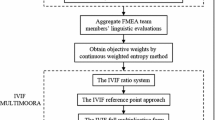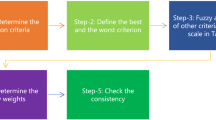Abstract
One of the most popular structured approaches in risk assessment is Failure Mode and Effects Analysis (FMEA) that helps in discovering potential failures existing within the design of a product or process. But numerous inadequacies are conjoined with it, for example, Risk Priority Number (RPN) used in FMEA fails to consider the individual effects of the risk factors, thereby neglecting the priority importance of each potential failure modes (PFMs). In this paper, a novel approach, namely, REV method is proposed, where subjective weights of risk factors are determined by using Interval number based Best Worst Method (BWM) to evaluate the weights of risk factors and determine their importance. REV is proposed as an alternative to RPN and aims to improve FMEA that could efficiently handle the vagueness and uncertainty of real-life situations. It is benefitted from decisions of both probability of risk of failure, for assessing the individual influence of the risk factors, as well as priority weights of PFMs from the preference decisions making ability of the MCDM methods with conflicting criteria. It is a user-friendly, flexible approach where suitable MCDM method of choice can be used for obtaining REVs. Here, MCDM techniques of TOPSIS, VIKOR, PROMETHEE and EDAS are used for reviewing individual impacts of PFMs. Furthermore, the proposed approach is endorsed with a case study involving failures in components of submersible pumps used in a power plant. The model is validated using Kendall Tau coefficient computed for different REVs and results are found to be satisfactory (0.849 for TOPSIS-VIKOR, 0.832 for PROMETHEE-EDAS, 0.851 for VIKOR- EDAS and 0.934 for TOPSIS- EDAS).





Similar content being viewed by others
Abbreviations
- BWM:
-
Best Worst Method
- CC j :
-
Closeness Coefficient Value
- CoCoSo:
-
A combined compromise solution
- COPRAS:
-
The complex proportional assessment method
- D:
-
Detection
- DEA:
-
Data Envelopment Analysis
- DEMATEL:
-
Decision-Making Trial and Evaluation Laboratory
- DM:
-
Decision Maker
- DOS:
-
Degree of safety
- DSS:
-
Decision support system
- EDAS:
-
Evaluation based on distance from average solution
- FAHP:
-
Fuzzy Analytic Hierarchy Process
- FANP:
-
Fuzzy Analytic Network Process
- FMEA:
-
Failure Modes and Effects Analysis
- FUCOM:
-
The full consistency method
- FVIKOR:
-
Fuzzy vlsekriterijuskaoptimizacija I komoromisnoresenje
- GMCDM:
-
Group multiple criteria decision-making
- GRA:
-
Grey Relational Analysis
- ITLV-TOPSIS:
-
Interval 2-tuple linguistic variables-technique for order of preference by similarity to ideal solution
- IVSF-TOPSIS:
-
Interval -valued spherical fuzzy extension of technique for order preference by similarity to ideal solution
- MADM:
-
Multi-Attribute Decision-Making
- MCDM:
-
Multi-Criteria Decision-Making
- MOORA:
-
Multi-objective optimization on the basis of ratio analysis
- NAHP:
-
Neutrosophic analytic network process
- O:
-
Occurrence
- OC:
-
Operator Competency
- PFM:
-
Potential Failure Mode
- PROMETHEE:
-
Preference ranking organization method for enrichment evaluation
- R-BWM:
-
Rough-best worst method
- REV:
-
Risk Expected Value
- RPN:
-
Risk Priority Number
- S:
-
Severity
- SWARA:
-
Step-wise weight assessment ratio analysis
- TOPSIS:
-
Technique for order of preference by similarity to ideal solution
- VIKOR:
-
vlsekriterijuskaoptimizacija I komoromisnoresenje
References
Aghaloo K, Chiu YR (2020) Identifying optimal sites for a rainwater-harvesting agricultural scheme in Iran using the Best-Worst Method and fuzzy logic in a GIS-based decision support system. Water 12(7):1913
Akoglu H (2018) User’s guide to correlation coefficients. Turkish J Emerg Med 18(3):91–93
Alvandi E, Soleimani-Sardo M, Meshram SG, Farid Giglou B, Dahmardeh Ghaleno MR (2021) Using Improved TOPSIS and Best Worst Method in prioritizing management scenarios for the watershed management in arid and semi-arid environments. Soft Comput 25(16):11363–11375
Athawale VM, Chakraborty S (2010) Facility layout selection using PROMETHEE II method. IUP J Operat Manag 9(1/2):81
Bao J, Johansson J, Zhang J (2017) An occupational disease assessment of the mining industry’s occupational health and safety management system based on FMEA and an improved AHP model. Sustainability 9(1):94
Başhan V, Demirel H, Gul M (2020) An FMEA-based TOPSIS approach under single valued neutrosophic sets for maritime risk evaluation: the case of ship navigation safety. Soft Comput 24(24):18749–18764
Ben‐Daya M, Raouf A (1996) A revised failure mode and effects analysis model. Int J Qual Reliabil Manag
Bhattacharjee P, Dey V, Mandal UK (2020) Risk assessment by failure mode and effects analysis (FMEA) using an interval number based logistic regression model. Saf Sci 132:104967
Boral S, Chakraborty S (2021) Failure analysis of CNC machines due to human errors: an integrated IT2F-MCDM-based FMEA approach. Eng Fail Anal 130:105768
Bowles JB, Peláez CE (1995) Fuzzy logic prioritization of failures in a system failure mode, effects and criticality analysis. Reliab Eng Syst Saf 50(2):203–213
Braglia M, Frosolini M, Montanari R (2003) Fuzzy TOPSIS approach for failure mode, effects and criticality analysis. Qual Reliab Eng Int 19(5):425–443
Carpitella S, Certa A, Izquierdo J, La Fata CM (2018) A combined multi-criteria approach to support FMECA analyses: a real-world case. Reliab Eng Syst Saf 169:394–402
Chang TW, Lo HW, Chen KY, Liou JJ (2019) A novel FMEA model based on rough BWM and rough TOPSIS-AL for risk assessment. Mathematics 7(10):874
Chin KS, Wang YM, Poon GKK, Yang JB (2009a) Failure mode and effects analysis by data envelopment analysis. Decis Supp Syst 48(1):246–256
Chin KS, Wang YM, Poon GKK, Yang JB (2009b) Failure mode and effects analysis using a group-based evidential reasoning approach. Comput Oper Res 36(6):1768–1779
Chowdhury P, Paul SK (2020) Applications of MCDM methods in research on corporate sustainability: a systematic literature review. Manag Environm Qual: an Int J
Das S, Dhalmahapatra K, Maiti J (2020) Z-number integrated weighted VIKOR technique for hazard prioritization and its application in virtual prototype based EOT crane operations. Appl Soft Comput 94:106419
Das I, Panchal D, Tyagi M (2021) A novel PFMEA-Doubly TOPSIS approach-based decision support system for risk analysis in milk process industry. Int J Qual Reliabil Manag
Delice EK, Can GF (2020) A new approach for ergonomic risk assessment integrating KEMIRA, best–worst and MCDM methods. Soft Comput 24(19):15093–15110
El Mokrini A, Kafa N, Dafaoui E, El Mhamedi A, Berrado A (2016) Evaluating outsourcing risks in the pharmaceutical supply chain: Case of a multi-criteria combined fuzzy AHP-PROMETHEE approach. IFAC-PapersOnLine 49(28):114–119
Emovon I (2018) Improving risk analysis capability of fmea using evaluation based on distance from average solution (EDAS): a case study of turbocharger system. J Mech Energy Eng 2(1):13–16
Gargama H, Chaturvedi SK (2011) Criticality assessment models for failure mode effects and criticality analysis using fuzzy logic. IEEE Trans Reliab 60(1):102–110
Geum Y, Cho Y, Park Y (2011) A systematic approach for diagnosing service failure: service-specific FMEA and grey relational analysis approach. Math Comput Model 54(11–12):3126–3142
Gu YK, Cheng ZX, Qiu GQ (2019) An improved FMEA analysis method based on QFD and TOPSIS theory. Int J Inter Des Manuf (IJIDeM) 13(2):617–626
Gul M, Ak MF (2021) A modified failure modes and effects analysis using interval-valued spherical fuzzy extension of TOPSIS method: case study in a marble manufacturing facility. Soft Comput 25(8):6157–6178
Guo J, Lin Z, Zu L, Chen J (2019) Failure modes and effects analysis for CO 2 transmission pipelines using a hesitant fuzzy VIKOR method. Soft Comput 23(20):10321–10338
Hu YP, You XY, Wang L, Liu HC (2019) An integrated approach for failure mode and effect analysis based on uncertain linguistic GRA–TOPSIS method. Soft Comput 23(18):8801–8814
Khalilzadeh M, Ghasemi P, Afrasiabi A, Shakeri H (2021) Hybrid fuzzy MCDM and FMEA integrating with linear programming approach for the health and safety executive risks: a case study. J Modell Manag
Kilic HS, Yalcin AS (2020) Modified two-phase fuzzy goal programming integrated with IF-TOPSIS for green supplier selection. Appl Soft Comp 93:106371
Kosztyán ZT, Csizmadia T, Kovács Z, Mihálcz I (2020) Total risk evaluation framework. Int J Qual Reliability Manag
Kumar D, Kumar P (2009) Multi-factor failure mode critically analysis using TOPSIS. J Ind Eng, Int 5(8):1–9
Li GF, Li Y, Chen CH, He JL, Hou TW, Chen JH (2020) Advanced FMEA method based on interval 2-tuple linguistic variables and TOPSIS. Qual Eng 32(4):653–662
Liang F, Brunelli M, Rezaei J (2020) Consistency issues in the best worst method: Measurements and thresholds. Omega 96:102175
Liu HC, Liu L, Lin QL (2013) Fuzzy failure mode and effects analysis using fuzzy evidential reasoning and belief rule-based methodology. IEEE Trans Reliab 62(1):23–36
Liu HC, You JX, Fan XJ, Lin QL (2014) Failure mode and effects analysis using D numbers and grey relational projection method. Expert Syst Appl 41(10):4670–4679
Liu HC, Chen YZ, You JX, Li H (2016) Risk evaluation in failure mode and effects analysis using fuzzy digraph and matrix approach. J Intell Manuf 27(4):805–816
Liu HC, Li Z, Song W, Su Q (2017) Failure mode and effect analysis using cloud model theory and PROMETHEE method. IEEE Trans Reliab 66(4):1058–1072
Lo HW, Shiue W, Liou JJ, Tzeng GH (2020) A hybrid MCDM-based FMEA model for identification of critical failure modes in manufacturing. Soft Comput 24(20):15733–15745
Lolli F, Ishizaka A, Gamberini R, Rimini B, Messori M (2015) FlowSort-GDSS–A novel group multi-criteria decision support system for sorting problems with application to FMEA. Expert Syst Appl 42(17–18):6342–6349
Lolli F, Gamberini R, Rimini B, Pulga F (2016) A revised FMEA with application to a blow moulding process. Int J Qual Reliab Manag
Melo de RM, Dos Santos ER, Ferreira MHL, Santos LPDS (2020) Quality management system in educational institutions: integration of FMEA and PROMETHEE II. Global J Res Eng
Mishra AR, Mardani A, Rani P, Zavadskas EK (2020) A novel EDAS approach on intuitionistic fuzzy set for assessment of health-care waste disposal technology using new parametric divergence measures. J Clean Prod 272:122807
Mohsen O, Fereshteh N (2017) An extended VIKOR method based on entropy measure for the failure modes risk assessment–a case study of the geothermal power plant (GPP). Saf Sci 92:160–172
Opricovic S, Tzeng GH (2007) Extended VIKOR method in comparison with outranking methods. Eur J Oper Res 178(2):514–529
Panchal D, Singh AK, Chatterjee P, Zavadskas EK, Keshavarz-Ghorabaee M (2019) A new fuzzy methodology-based structured framework for RAM and risk analysis. Appl Soft Comput 74:242–254
Panchal D, Chatterjee P, Sharma R, Garg RK (2021) Sustainable oil selection for cleaner production in Indian foundry industries: a three phase integrated decision-making framework. J Cleaner Prod 313:127827
Panchal D, Chatterjee P, Pamucar D, Yazdani M (2022) A novel fuzzy-based structured framework for sustainable operation and environmental friendly production in coal-fired power industry. Int J Intell Syst 37(4):2706–2738
Panchal D, Mangla SK, Tyagi M, Ram M (2018) Risk analysis for clean and sustainable production in a urea fertilizer industry. Int J Qual Reliability Manag
Paul S, Jana D, Mondal SP, Bhattacharya P (2017) Optimal harvesting of two species mutualism model with interval parameters. J Intell Fuzzy Syst 33(4):1991–2005
Rezaei J (2015) Best-worst multi-criteria decision-making method. Omega 53:49–57
Rezaei J (2016) Best-worst multi-criteria decision-making method: Some properties and a linear model. Omega 64:126–130
Rezaei J (2020) A concentration ratio for nonlinear best worst method. Int J Inf Technol Decis Mak 19(03):891–907
Sałabun W, Wątróbski J, Shekhovtsov A (2020) Are mcda methods benchmarkable? a comparative study of TOPSIS, VIKOR, COPRAS, and PROMETHEE II methods. Symmetry 12(9):1549
Samara B, Randles RH (1988) A test for correlation based on Kendall’s tau. Commun Stat-Theory Methods 17(9):3191–3205
Sofuoğlu MA (2020) Fuzzy applications of Best-Worst method in manufacturing environment. Soft Comput 24(1):647–659
Stamatis DH (2003) Failure mode and effect analysis: FMEA from theory to execution. Quality Press
Stojčić M, Zavadskas EK, Pamučar D, Stević Ž, Mardani A (2019) Application of MCDM methods in sustainability engineering: a literature review 2008–2018. Symmetry 11(3):350
Tong LI, Chen CC, Wang CH (2007) Optimization of multi-response processes using the VIKOR method. Int J Adv Manuf Technol 31(11–12):1049–1057
Valencia D, Lillo RE, Romo J (2019) A Kendall correlation coefficient between functional data. Adv Data Anal Classif 13(4):1083–1103
Vinodh S, Aravindraj S, Narayanan RS, Yogeshwaran N (2012) Fuzzy assessment of FMEA for rotary switches: a case study. TQM J
Wan C, Yan X, Zhang D, Qu Z, Yang Z (2019) An advanced fuzzy Bayesian-based FMEA approach for assessing maritime supply chain risks. Trans Res Part e: Log Trans Rev 125:222–240
Wu Z, Abdul-Nour G (2020) Comparison of multi-criteria group decision-making methods for urban sewer network plan selection. CivilEng 1(1):26–48
Xu K, Tang LC, **e M, Ho SL, Zhu ML (2002) Fuzzy assessment of FMEA for engine systems. Reliab Eng Syst Saf 75(1):17–29
Yazdani M, Abdi MR, Kumar N, Keshavarz-Ghorabaee M, Chan FT (2019a) Improved decision model for evaluating risks in construction projects. J Constr Eng Manag 145(5):04019024
Yazdani M, Chatterjee P, Pamucar D, Abad MD (2019b) A risk-based integrated decision-making model for green supplier selection. Kybernetes
Yazdani M, Torkayesh AE, Chatterjee P (2020) An integrated decision-making model for supplier evaluation in public healthcare system: the case study of a Spanish hospital. J Enterprise Inform Manag
Yousefi S, Valipour M, Gul M (2021) Systems failure analysis using Z-number theory-based combined compromise solution and full consistency method. Appl Soft Comput 113:107902
Yucesan M, Gul M (2021) Failure modes and effects analysis based on neutrosophic analytic hierarchy process: method and application. Soft Comput 25(16):11035–11052
Yucesan M, Gul M, Celik E (2021) A holistic FMEA approach by fuzzy-based bayesian network and best–worst method. Complex Intell Syst 7(3):1547–1564
Zadeh LA (1965) Fuzzy sets. Inform Control 8(3):338–353
Zadeh LA (1975) The concept of a linguistic variable and its application to approximate reasoning-III. Inf Sci 9(1):43–80
Zhang Z, Chu X (2011) Risk prioritization in failure mode and effects analysis under uncertainty. Expert Syst Appl 38(1):206–214
Zhu J, Shuai B, Li G, Chin KS, Wang R (2020) Failure mode and effect analysis using regret theory and PROMETHEE under linguistic neutrosophic context. J Loss Prev Process Ind 64:104048
Funding
No funding received for this paper.
Author information
Authors and Affiliations
Corresponding author
Ethics declarations
Conflict of Interest
Authors declare no conflict of interest.
Ethical approval
This article does not contain any studies with human participants or animals performed by any of the authors.
Additional information
Publisher's Note
Springer Nature remains neutral with regard to jurisdictional claims in published maps and institutional affiliations.
Rights and permissions
About this article
Cite this article
Bhattacharjee, P., Dey, V. & Mandal, U.K. Failure Mode and Effects Analysis (FMEA) using interval number based BWM—MCDM approach: Risk Expected Value (REV) method. Soft Comput 26, 12667–12688 (2022). https://doi.org/10.1007/s00500-022-07264-9
Accepted:
Published:
Issue Date:
DOI: https://doi.org/10.1007/s00500-022-07264-9




